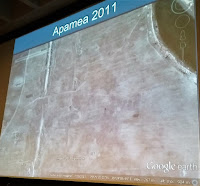War, Antiquities, and Responses: Colgate University Conference on Preserving Cultural Heritage in Times of Conflict
 |
| Monuments Men author Robert Edsel speaking at Colgate University. |
From the looters shovel to the auction gavel, large scale cultural property theft and destruction occur during times of instability. That is how Dr. Michael Danti framed the discussion for last week’s conference titled Preserving Cultural Heritage in Times of Conflict, sponsored by Colgate University and the Penn Museum–Near Eastern Section.
Danti is a classics professor at Colgate, a consulting scholar with the University of Pennsylvania Museum, and an archaeologist with expertise in the destruction of cultural heritage in Iraq and Syria. He described the current wave of cultural property crime from conflict zones as “voracious.”
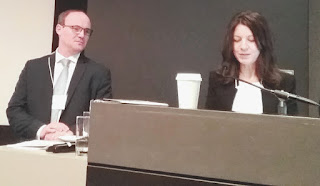 |
| Conference organizers Dr. Michael Danti and Dr. Carolyn Guile |
Danti and Dr. Carolyn Guile organized the conference to answer questions about what threatens cultural property today, what can be done to protect cultural heritage during wartime, and what lessons can past conflicts teach.
Guile, an associate professor of art history at Colgate University, called attention to deliberate cultural cleansing, which is reflected by contemporary heritage destruction. Today’s level of harm to cultural property, not seen since World War II she noted, warrants a serious look into heritage preservation.
Guile’s words echoed observations made by keynote lecturer Robert Edsel, author of the best-selling book, The Monuments Men: Allied Heroes, Nazi Thieves and the Greatest Treasure Hunt in History and founder of the Monuments Men Foundation. Edsel pointed out that advance planning when armed conflict breaks out is a valuable lesson taught by General Dwight Eisenhower’s Monuments Men during the Second World War, which is important because the destruction of heritage is a precursor to the destruction of peoples.
In the modern era, special challenges to cultural heritage protection are posed by the nature of the art trade, the “largest lawful unregulated business” in the world, Danti remarked. The art market is robust, and thieves middle men, and complicit experts take advantage of it, he said. Danti stated that the good news today is that “collectors may be aware that their purchases may be related to terrorism and other activity.” That is why purchases have declined since 2014. The bad news, he warned, is that most of today’s conflict antiquities looted from the Middle East won’t hit the market for maybe five or ten years. That is because mass cultural property crime take decades to address.
Danti called attention to Article 27 of the Universal Declaration of Human Rights (UDHR), adopted by the UN General Assembly in 1948 following WWII. “Everyone has the right freely to participate in the cultural life of the community,” the UDHR document recites. Terror groups, “ISIS, and extremists,” by contrast, “represent the antithesis of cultural heritage protection,” Danti reflected.
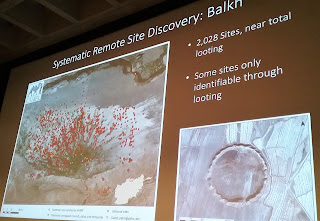 |
| AHMP satellite imagery depicting over 2,000 looted sites in the Balk region of Afghanistan, as shown by Emily Bloak. |
Emily Bloak, part of the University of Chicago’s Afghan Heritage Mapping Partnership (AHMP), monitors threats to cultural heritage in some of the world’ most volatile regions. “In both conflict areas [Syria/Iraq and Afghanistan], looted antiquities are believed to fund terrorism,” she reported, adding that major threats to cultural heritage in Afghanistan currently are mining, development, and agriculture, particularly related to opium production.
Looting is a large threat in Afghanistan and “only one aspect of a larger, complex relationship…,” Bloak observed. Mining is a problem that threatens cultural heritage, such as at Mes Aynak. Energy development, like the proposed Turkmenistan–Afghanistan–Pakistan–India (TAPI) natural gas pipeline, also poses a risk, she remarked.
When asked about arrests in Afghanistan for those who destroy cultural property, Bloak said that there were none as this was not “something that is monitored at all.”
Syrian archaeologist Dr. Amr al-Azm, associate professor at Shawnee State University, drew attention to the importance of Syrian cultural heritage and the importance of non-state actors to preserve it. Syria has six world heritage sites, and al-Azm related that every Syrian lives on top of an archaeological site, near a site, or within a stone’s throw of a site.
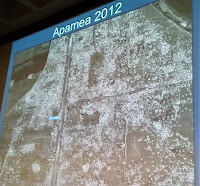 |
| Archaeological site looting in Apamea, 2012. |
Why is cultural heritage protection important in Syria? “People without their history, their culture, are lost. They are basically disconnected,” al-Azm explained. There is no binary, no one or another, when choosing between saving cultural heritage or people in wartime, al-Azm argued. You focus on the humanitarian, “not stones.” But “this cultural heritage is important to people on both sides of the conflict,” meaning that the shared heritage of the Syrian people, no matter what side of the conflict they are on, will help people “reconnect” when the war ends. “Saving this history … is about saving the future of Syria too.”
Dr. al-Azm listed some of Syria’s significant cultural heritage losses, including Krak de Chevalier, saying “it’s pretty badly damaged, and St Simeon, which was damaged by air strikes.
Apamea, meanwhile, has suffered significant looting. The photo at top right, shown by al-Azm, depicts numerous looters pits that emerged over the Syrian archaeological site starting in 2012, and they have spread out since that time, he said. Compare the pockmarked site in 2012 with the image at left showing the same site in 2011.
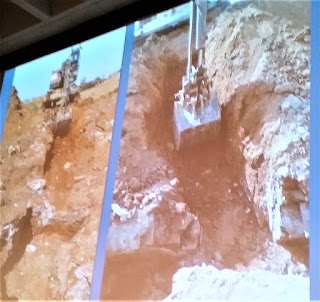 |
|
Industrialized looting in Syria using heavy machinery, depicted by Dr. Amr al-Azm’s slide.
|
Dr. al-Azm declared that the looting and sale of antiquities by ISIS was “very, very lucrative.” The terror group didn’t start it, but they institutionalized and industrialized the process, he contended. They were “involved at every stage,” from looting to sale.
Oil refineries, meanwhile, have been moved on top of archaeological sites in the hope that their new locations might afford some protection against bombing.
Heritage management specialist Dr. Allison Cuneo of Cultural Property Consultants instructed that intentional destruction of religious monuments by ISIS in Syria and northern Iraq have caused noticeable damage. Cuneo displayed pie charts, shown at left, illustrating that 24% of ancient, 22% of Christian, and 13% of Yezidi monuments and sites have suffered the greatest number of attacks.
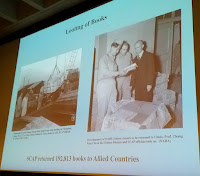 |
| Dr. Ricardo Elia’s slide chronicling the return of Japanese appropriated books to Allied countries |
Building on both the current reports from the Middle East and Edsel’s presentation about how cultural protection efforts in past wars could help tackle current challenges, historian Dr. John Radzilowski of the University of Alaska spoke about the moral and legal claims to looted cultural property in East Central Europe after 1945, and Boston University professor of archaeology Dr. Ricardo Elia added fresh information from new research on the Japanese appropriation of cultural heritage during the War in the Pacific, which resulted in the return of thousands of books by the Supreme Commander for the Allied Powers (SCAP) to allied countries after World War II.
 |
| Cambodian newspapers celebrate the repatriation of cultural property looted during that country’s bloody past. Presented by Tess Davis. |
Going beyond the armed conflicts of the 1940’s, lawyer and archaeologist Tess Davis, executive director of the Antiquities Coalition highlighted lessons learned from Cambodia, where severe cultural property looting lasted from 1970 through 1998. Cultural cleansing in the Killing Fields by the Khmer Rouge included devastation suffered by 73 Catholic Churches, 130 cham mosques, and 3369 Buddhist temples, all while the Khmer Rouge held a seat at the UN. She noted that heritage protection was not part of UN peacekeepers’ mandate in Cambodia.
Reclamation by the Cambodian people in recent years of looted cultural property–specifically ancient statues housed both in American museums and offered for sale at a New York auction house–has been a bright spot set against the backdrop of an otherwise dark past, Davis told conference attendees.
She called on nations to join relevant international agreements on cultural property protection, to close borders to close to undocumented cultural objects from countries in crisis, and for international legal scholars to “develop a framework for filling gaps in the chain of title for cultural objects caused by armed conflict, regime changes, or other crises.”
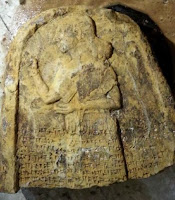 |
| Image of an object found on Abu Sayyaf’s WhatsApp that is subject to a current federal forfeiture complaint. |
A federal forfeiture lawsuit initiated the return of a Duryodhana and other statues to Cambodia. Now a new kind of forfeiture case is winding its way through the American court system. CHL’s author informed conference participants that the case is innovative because it applies the USA PATRIOT Act to claim ownership of ISIS (aka ISIL) cultural property, ensuring that these conflict artifacts will not circulate in the marketplace and generate blood income. Unlike typical forfeiture cases that support the Department of Homeland Security’s much criticized “seize and send” policy–a policy that seizes illegally trafficked artifacts and then sends them to their countries of origin after publicized law enforcement repatriation ceremonies, but without criminal prosecutions of the wrongdoers–this new forfeiture case aims to give legal support to the military’s prosecution of a war that aims to take down a terror group.
The case bears the name United States of America v. One Gold Ring with Carved Gemstone, An Asset of ISIL Discovered on Electronic Media of Abu Sayyaf, President of ISIL Antiquities Department et al. It started with a US Delta Force raid on a Syrian compound occupied by Abu Sayyaf, identified by discovered documents as ISIS’s minister of antiquities. About 700 cultural artifacts were found during the raid and repatriated. Four cultural heritage objects, depicted on electronic media recovered from the raid, are the subject of the forfeiture case. In their court complaint, federal prosecutors allege, “Abu Sayyaf’s electronic media had multiple photographs of other antiquities. These photographs were staged in a manner consistent with the sale of antiquities.” They attorneys argue that they “are forfeitable as foreign assets of ISIL … as ISIL has and is engaged in planning and perpetrating federal crimes of terrorism . . . .“
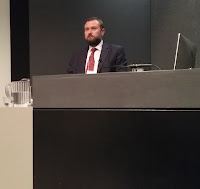 |
| Dr. Brian Brown |
Shifting attention from the judicial to the executive branch, Dr. Brian Brown, a private cultural property consultant and a former cultural heritage analyst with the US State Department, outlined policy reforms that he supports. They include
- allowing import restrictions covering at-risk transnational cultural property under the Convention on Cultural Property Implementation Act (CPIA) to last longer than five years;
- including explicit penalties, particularly fines, for violations of the CPIA, just like the Lacey Act, which protects endangered wildlife;
- requiring export certificates, not affidavits, to support the lawful entry of CPIA imports;
- having the State Department impose emergency import protection controls when needed to quickly safeguard cultural objects in jeopardy of looting;
- assigning a specific Department of Defense office as a single point of contact on cultural heritage matters during armed conflicts; and
- devoting more resources to the State Department, the Department of Homeland Security (DHS), and other agencies to shore up cultural heritage protection. Brown said that DHS only has one person overseeing its Cultural Property Art and Antiquities Investigations, that only three people at the State Department administer 16 CPIA treaties, and that “all relevant offices are severely understaffed.”
Brown informed conference participants that the interagency coordinating committee called for by the Protect and Preserve International Cultural Property Act, which the president signed into law last year, has met four times.
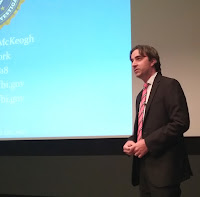 |
| FBI Special Agent Christopher McKeogh |
Special Agent Christopher McKeogh, an art and antiquities crime specialist with the FBI’s New York field office, was the conference’s final speaker.
“We get a lot of requests for repatriation of cultural assets.” But “recovered items rarely lead to prosecution of subjects.” The trail is cold, he said.
He explained that his agency’s goals are to identify networks of looters, their routes, and methods of object removal from countries of origin; to uncover long-term storage locations; to identify end-users and collectors; and to recover illicit cultural heritage objects.
McKeough noted that smuggled cultural property frequently is misidentified as antiques, pottery, and handicrafts on customs forms, and he revealed that looted items often are hidden in larger shipments.
The agent highlighted the connection between antiquities crime and money laundering, which is why it is important for authorities to follow the money, to compare documentation to known facts, and to investigate whether money laundering techniques (like the use of shell companies) are obscuring terrorist financing operations, he explained.
Some proactive measures to combat cultural heritage trafficking, McKeough suggested, include maintaining ties with foreign law enforcement, working closely with the FBI Counterterrorism Division, liaising with galleries and auction houses, monitoring internet sales and auctions, and fostering community outreach.
Conference discussions were lead by Dr. Richard Zettler of the Penn Museum-Near Eastern Section and by Colgate University professors Rebecca Ammerman, Robert Garland, Padma Kaimal, Xan Kam, Robert Kraynak, Elizabeth Marlowe. Additional sponsors of the conference included Colgate University’s Office of the President, Center for Freedom and Western Civilization, Department of Classics, Department of Art and Art History, Global Engagements, University Studies. The conference took place took place on October 18-20, 2017.
Text and original photos copyrighted 2010-2017 by Cultural Heritage Lawyer, a blog commenting on matters of cultural property law, art law, cultural heritage policy, antiquities trafficking, museum risk management, and archaeology. Blog url: culturalheritagelawyer.blogspot.com. Any unauthorized reproduction or retransmission without the express written consent of CHL is strictly prohibited. Visit www.redarchresearch.org.


